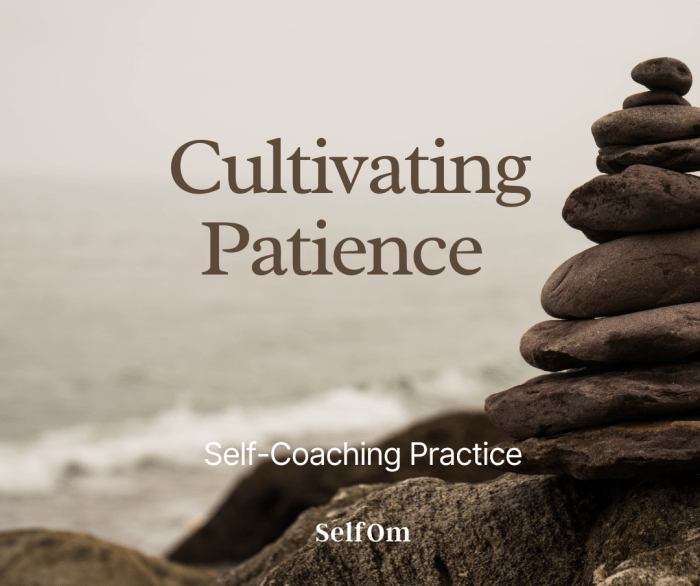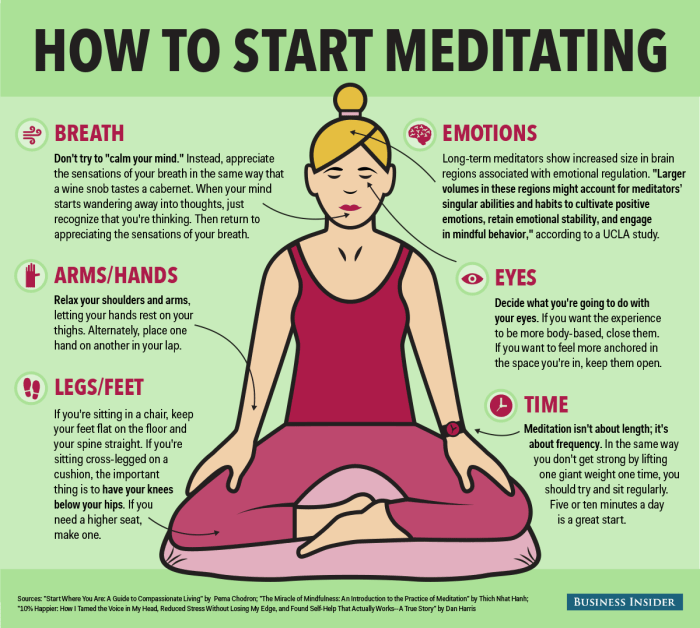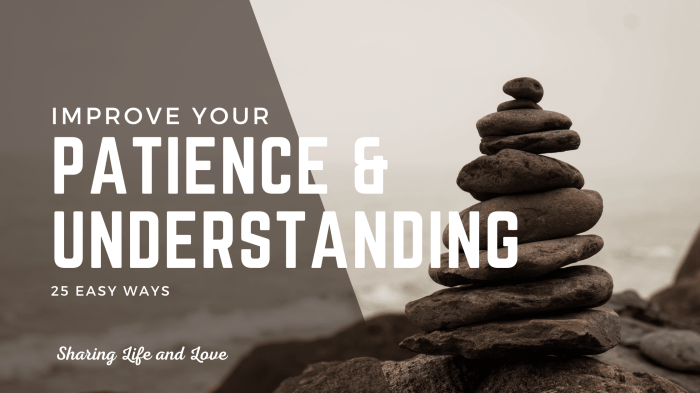With How to Meditate for Cultivating More Patience in Your Life at the forefront, this paragraph opens a window to an amazing start and intrigue, inviting readers to embark on a storytelling journey filled with unexpected twists and insights.
This article introduces the concept of meditation for cultivating patience, emphasizing its importance in daily life and the benefits it brings. It explores how meditation helps in developing patience and provides techniques to incorporate mindfulness practices for enhancing patience.
Introduction to Meditation for Cultivating Patience

Meditation is a practice that involves focusing the mind and eliminating distractions to achieve a sense of calm and inner peace. It is a powerful tool that can help individuals cultivate patience in their daily lives by promoting self-awareness and emotional regulation.
Are you a busy person looking to incorporate meditation into your daily routine? Check out this 10-Minute Meditation for Busy People guide for quick and effective meditation practices.
Importance of Cultivating Patience
- Patience is essential for maintaining healthy relationships and effective communication with others.
- It helps in reducing stress and anxiety by teaching individuals to stay calm in challenging situations.
- Developing patience leads to improved decision-making skills and better problem-solving abilities.
Benefits of Incorporating Meditation
- Meditation encourages mindfulness, which is key to developing patience and being present in the moment.
- It enhances self-control and emotional stability, reducing impulsive reactions and promoting a more thoughtful response.
- Regular meditation practice can increase overall resilience and tolerance for uncertainty, leading to a more patient outlook on life.
- Meditation teaches individuals to observe their thoughts and emotions without reacting impulsively.
- Through regular practice, individuals learn to accept discomfort and challenging emotions with equanimity.
- By focusing on the present moment, meditation helps in cultivating patience by reducing anxiety about the future.
- Counting breaths: By counting breaths during meditation, individuals learn to stay focused and patient despite distractions.
- Body scan meditation: This practice involves systematically focusing on different parts of the body, promoting patience and awareness of bodily sensations.
- Loving-kindness meditation: By cultivating compassion towards oneself and others, individuals develop patience in dealing with difficult emotions and situations.
- Practice deep belly breathing by inhaling slowly through your nose, filling your lungs with air, and exhaling deeply through your mouth. Repeat this process several times, focusing on the sensation of your breath entering and leaving your body.
- Engage in mindful walking by paying attention to each step you take, the sensations in your body, and the environment around you. This practice can help you stay grounded and patient in moments of stress or impatience.
- Practice mindful listening by giving your full attention to the speaker without interrupting or formulating a response in your mind. By listening attentively, you can cultivate patience and understanding in your interactions with others.
- Practice active listening: Instead of rushing to respond, take the time to truly understand the other person’s perspective before reacting.
- Pause before reacting: When faced with a frustrating situation, take a moment to breathe and collect your thoughts before responding impulsively.
- Cultivate empathy: Try to see things from the other person’s point of view to foster understanding and compassion, which can lead to more patient responses.
- Set realistic expectations: Understand that things may not always go as planned and be prepared to adapt without getting frustrated.
- Practice gratitude: Focus on the positive aspects of your life to shift your perspective and avoid becoming easily irritated by minor inconveniences.
- Engage in mindfulness: Stay present in the moment and avoid getting caught up in negative thoughts that can lead to impatience.
- Enhanced emotional intelligence: Patience allows you to regulate your emotions effectively, leading to better communication and conflict resolution skills.
- Increased resilience: The ability to remain patient in the face of challenges can help you persevere through tough times and bounce back stronger.
- Improved self-control: Practicing patience regularly can lead to better impulse control and decision-making, resulting in more positive outcomes.
Understanding Patience in Meditation

Patience plays a crucial role in successful meditation, as it involves allowing thoughts to come and go without judgment or attachment. By cultivating patience, individuals can navigate distractions and find inner stillness more effectively.
Struggling with negative thoughts? Discover 7 Ways to Use Meditation to Overcome Negative Thoughts and harness the power of meditation to cultivate a positive mindset.
Meditation as a Tool for Developing Patience
Examples of Cultivating Patience through Meditation Practices
Techniques and Practices for Meditating to Cultivate Patience

Practicing meditation can be a powerful tool for developing patience in your daily life. By incorporating specific techniques and mindfulness practices, you can enhance your ability to remain calm and composed in challenging situations.
Unlock the power of present moment awareness through meditation. Learn How to Meditate for Unlocking the Power of Present Moment Awareness and enhance your mindfulness practice.
Breathing Exercises for Developing Patience
Breathing exercises are a fundamental aspect of meditation that can aid in cultivating patience. Focusing on your breath helps you stay present in the moment, allowing you to observe your thoughts and emotions without reacting impulsively. Try the following breathing exercise to promote patience:
Mindfulness Practices to Promote Patience in Daily Life
Mindfulness is the practice of being fully present and aware of your thoughts, feelings, and surroundings without judgment. By incorporating mindfulness practices into your daily routine, you can cultivate patience and respond to challenging situations with greater clarity. Here are some mindfulness techniques to help you promote patience:
Overcoming Challenges and Obstacles in Meditation for Patience

Meditation can be a powerful tool for cultivating patience, but it comes with its own set of challenges. Here are some common obstacles faced when trying to develop patience through meditation and strategies to overcome them.
Managing Racing Thoughts
During meditation, it’s common for the mind to wander and for racing thoughts to take over. This can lead to impatience as you struggle to focus. To overcome this challenge, try acknowledging the thoughts without judgment and gently guiding your attention back to your breath or mantra. Consistent practice will help train your mind to stay present.
Dealing with Physical Discomfort
Sitting still for an extended period can sometimes lead to physical discomfort, such as stiffness or pain. When faced with these sensations, resist the urge to immediately react by changing your position. Instead, practice observing the discomfort with curiosity and kindness. Over time, you’ll learn to sit with discomfort without feeling restless or impatient.
Impatience with Progress
Patience is not developed overnight, and it’s natural to feel frustrated when you don’t see immediate results in your meditation practice. Remember that progress is subtle and may not always be obvious. Trust the process and continue showing up on your mat or cushion every day. Consistency and perseverance are key to cultivating patience through meditation.
Integrating Patience from Meditation into Daily Life: How To Meditate For Cultivating More Patience In Your Life

After cultivating patience through meditation practices, it is essential to integrate this newfound skill into your daily life. Patience can help you navigate challenging situations with a calm and collected mindset, leading to better decision-making and improved overall well-being.
Applying Patience in Real-Life Situations
Maintaining a Patient Mindset Outside of Meditation
Long-Term Effects of Incorporating Patience into Daily Routines, How to Meditate for Cultivating More Patience in Your Life
By consistently applying patience in your daily life, you can experience reduced stress levels, improved relationships, and increased overall satisfaction with your life.
In conclusion, cultivating patience through meditation offers a transformative journey towards a more peaceful and fulfilling life. By integrating patience gained from meditation into daily experiences, individuals can navigate challenges with resilience and grace.